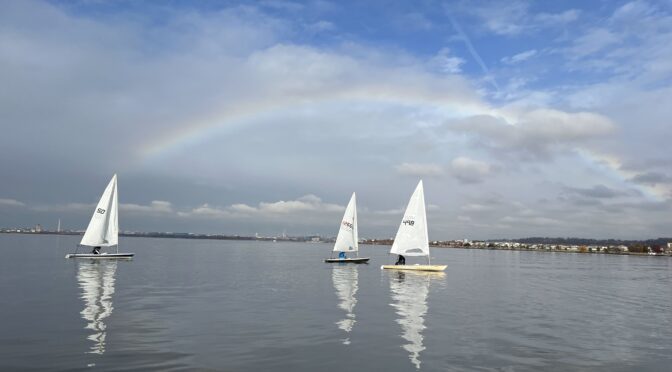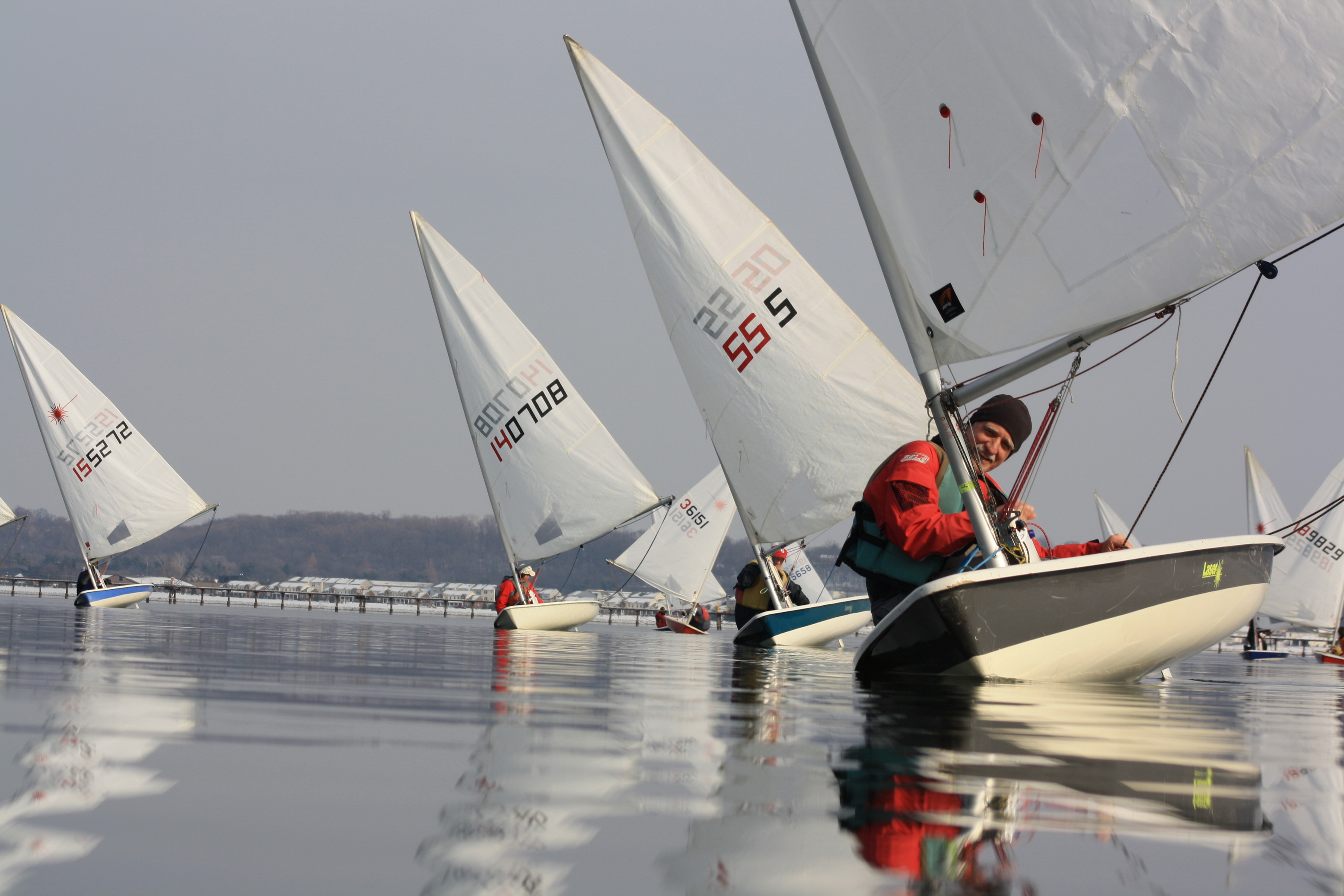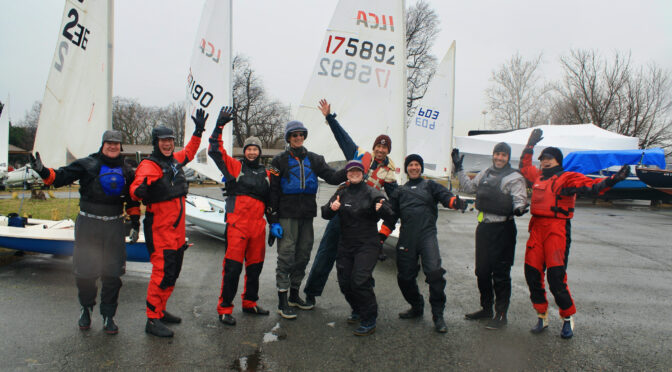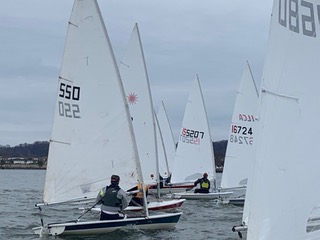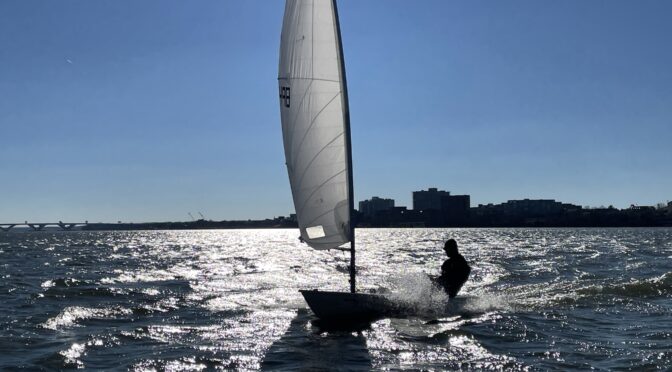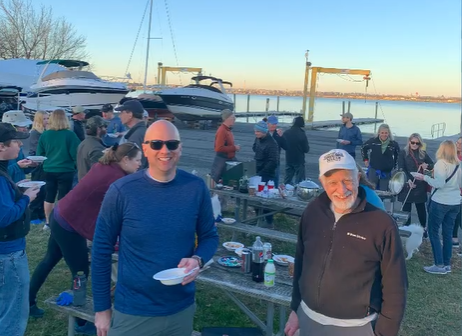PRSA Frostbite Lasers – November 26, 2023
By Dave Coughlin
Race 1: Conditions West at 0 to 1.5 knots, current just started flooding from south.
At Start it was apparent the pin was much closer to the windward mark. I set up near the pin and circled around watching where other players were setting up. I was successful at winning the pin and tacking to Port at 5 seconds until the gun. With the wind coming from left corner, I was most left boat and worked on not moving around to disturb the air flow, sitting on centerboard with aft leg behind mainsheet block, main was eased considerably to gain speed after start and create apparent wind, outhaul was 3 inches further out in center of boom of my widespread hand than usual. (Thumb to finger pinky spread full apart is my general rule of thumb) This is my standard and very technical distance (LOL) to evaluate location of outhaul. As boat speed and apparent wind increased, I gently trimmed the outhaul to increase point. On starboard the current caused an artificial header but more velocity. AKA, lee bowing the current. After the start I focused on as few tacks as possible to maintain speed. Prior to every tack I eased outhaul, came out of tack wide and started to build speed. 3 tacks total on this first beat. Rounded in first with a 7-boat length lead. Sailed high to get a better angle to the west breeze. This was not a great move but needed to maintain speed. Farley and Lloyd caught me in a following puff from behind and were able to sail lower. They had the puff I did not while the wind shifted to northeast, boats heading stayed the same but tacked from Starboard to Port. Since I sailed high initially, I was a sitting duck for the west downwind puff and the 150-degree shift to Northeast, they caught me, and I could not defend.
After leeward mark rounding it was a starboard tack fetch to finish with a more NNE direct, a tight reach. I was third and I always try to sail consistently and be top 3 every race.
Race 2: North at 2-4, current stronger from south.
Initial start was General Recalled. Boat was very favored but after Recall I did not want to be shut out so I decided to be conservative and start 1/3 down the line, avoiding the current induced pile up at the boat end. Thinking just get off the line and see what happens. Farley was closest to the RC boat and Lloyd was between both of us. We were the only three with boat speed to get free of the pack or off the starting line.
- As a side note: many sailors set up too late on the start line and they don’t start to accelerate at 12-7 seconds, but at 3-2 or 0 second. On these short courses the start is everything. My advice is to train to be over early on a few starts, just by a second or 2. You get free of pack and clear air. If not on the line in front row at 30 seconds you will consistently become 2nd row. (This is an entirely separate article to discuss and train too, how many have practiced the start line interception with timing, how many sailors have a watch and count down?)
Within seconds after the start, I knew I was third again since Farley and Lloyd were inside the shift and seemed to have more breeze. I rounded the weather mark in third. After the Leeward mark rounding, both leaders went left on course, I headed towards the deep channel and hoped to gain current leverage, sending me to the right, only one other boat (Brain) went right. When I was the most right, I thought I looked good, pointed higher, more breeze and current push, since it was so light air, I think it was artificial breeze generated by the current push that made me look good. As I closed in on the starboard lay line, the puff or current push near the channel had ended. I lost another boat from the left and rounded fourth. Jibed immediately and worked inside (against the current), catching the boat I lost upwind. I rounded and finished third.
Items to speak too:
- Light air, sit on centerboard, straddling the main sheet but be on the lookout on port since it takes time to free yourself to tack.
- At weather mark rounding, if capable, I will trim main from the boom block and pull free mainsheet (as many feet as I can get out of ratchet block) from ratchet block, in heavy air a must, in light air not as aggressive since speed can be gained in coordinated ease to speed. This is needed in a jibe set rounding, this ease allows me to bring the bow down and then jibe.
- In light air, roll tack to the max and as flattening trim in main slowly and flatten slowly. The longer you can have the air flowing over sails and water pushing over blades the better. But remember the rules…you can’t exit the tack faster than you went into the tack. But you can get immediately up to speed and not have speed build delay.
23-24 PRSA Frostbite Series #2


